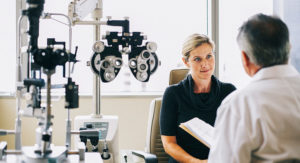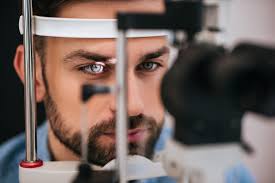
Diabetic retinopathy is the most common eye disease among diabetics, as well as the leading cause of blindness in American adults. In fact, diabetic retinopathy affects about half of all individuals with diabetes. Unfortunately, there is no cure for diabetic eye disease and it can cause irreversible symptoms. However, diabetic retinopathy can be managed. Read on below for more information, as well as answers to common patient questions.

Some of the content below has been provided by Dr. Cheryl Stoker, OD, and is medically reviewed for accuracy. Dr. Stoker is an excellent resource for information about diabetic eye care and health as she is herself a diabetic. Therefore, Dr. Stoker has a unique and experienced perspective for an eye care professional working with diabetics on maintaining their health. Some links have been added to audio transcripts to provide access to relevant resources or information.
Table of Contents:
- What is Diabetic Retinopathy?
- What is the treatment for Diabetic Retinopathy?
- Tips for avoiding Diabetic Retinopathy
Whether you need regular exams to monitor for diabetic retinopathy or if you have already been diagnosed, the experts at Louisiana Eye & Laser are here to help. Just call, schedule online, or stop by one of our locations to schedule your appointment.
What is Diabetic Retinopathy?
Answer provided by Dr. Cheryl Stoker. Transcript included below.
Dr. Cheryl Stoker, OD:
Okay. Diabetic retinopathy is… Well, there’s two forms. There’s non proliferative diabetic retinopathy and there’s proliferative diabetic retinopathy. Non proliferative is the beginning stage where the blood vessels in the retina swell and leak which causes hemorrhaging and swelling of the retina and the macula. The macula is the area where we get our central vision, so it’s a very important part of the retina because that’s what we use to basically see centrally with, and it’s located in the central part of the retina.
Proliferative diabetic retinopathy is the advanced stage where fragile new blood vessels grow and leak into the vitreous, which is the jelly-like substance in front of the retina. It can cause vitreal floaters, which are actually not floaters as much as they are blood, but it looks like floaters to the patient, but it’s actually blood that leaks out into the vitreous due to the hemorrhaging of the blood vessels. It can cause macula edema as well and even vision loss because diabetes is one of the leading causes of blindness.
[End of Dr. Stoker Audio Transcript]
Additional information about diabetic retinopathy
Diabetic retinopathy occurs when high blood sugar levels damage blood vessels in the retina. Diabetic retinopathy affects individuals with both type 1 and type 2 diabetes. In general, there are two stages of diabetic eye disease:
Non Proliferative Diabetic Retinopathy (NPDR)
NPDR is the early stage of diabetic eye disease. Many diabetics are unaware that they have NPDR, as symptoms are typically mild or nonexistent. In NPDR, the blood vessels in the retina may leak fluid, causing swelling of the macula. This is known as macula edema and it is the most common reason that people with diabetes lose their vision.
The blood vessels may also close off, causing a condition known as macular ischemia in which blood is unable to reach the macula. Sometimes tiny particles known as exudates can form in the retina. As NPDR progresses, symptoms such as blurry vision may begin to appear.

Proliferative Diabetic Retinopathy (PDR)
PDR is the advanced stage of diabetic eye disease that occurs when the retina grows new blood vessels in a process known as neovascularization. The new blood vessels can bleed into the vitreous, damaging vision. Effects may range from just a few dark floaters to complete loss of vision. Scar tissue from the new blood vessels can also impact vision, leading to macular problems or even a detached retina. As diabetic eye disease progresses, symptoms may begin to appear. Symptoms of PDR typically affect both eyes and may include:
- Floaters
- Blurred vision
- Blank or dark spots in your vision
- Poor night vision
- Colors appearing faded

What is the treatment for Diabetic Retinopathy?
Answer provided by Dr. Cheryl Stoker. Transcript included below.
Dr. Cheryl Stoker, OD:
When there’s extensive leaking of the blood vessels in the back of the eye in the retina, a specialist will use a laser to basically cauterize the bleeding in the retina. But the problem with that is when they do that, it leaves scars on the retina which can affect the vision, so it’s best to detect diabetic retinopathy early when the hemorrhaging is small so that there won’t be as many laser scars on the back of the eye. They also can use the laser to control the macular edema by controlling the leaking fluid. The problem with that is the macula is where we get our central vision, so if there’s a laser used on it, it will leave a scar which can actually affect our central vision.
There’s also intravitreal injection therapy which is used to treat macular edema, and there’s two drugs that do this. One is a steroid and the other is called an anti-VEGF agent, and both of those have been shown to reduce macular edema. The anti-VEGF drugs target a specific chemical in the eye called vascular endothelial growth factor or VEGF, and that is critical in causing abnormal blood vessels to grow under the retina. Several anti-VEGF drugs have been developed that block this, so an anti-VEGF drug can help treat macular edema by reducing growth of the abnormal blood vessels and slowing their leakage or hemorrhaging, which help slow down vision loss. The anti-VEGF drugs and steroid drugs are typically injected directly into the eye to treat diabetic retinopathy.

Tips for avoiding Diabetic Retinopathy
Answer provided by Dr. Cheryl Stoker. Transcript included below.
Dr. Cheryl Stoker, OD:
Yeah, coming in for an annual exam, keeping their blood sugar under control with medication and diet, that’s imperative. I mean, they have to. They can’t just take their medicine and think that diet is not important because they go hand in hand, and you can’t just diet and not take your medicine if your doctor has prescribed it. So those two things and getting a yearly eye exam, because like I said, the sooner we can detect diabetic retinopathy, the sooner it can be treated and hopefully preserve vision and avoid some vision loss, so those two things are imperative.

Visit Louisiana Eye & Laser!
All diabetics should receive a yearly dilated eye exam to check for diabetic retinopathy, regardless of whether or not they have symptoms. Over the years, the experts at Louisiana Eye & Laser have diagnosed and managed diabetic eye disease in countless patients. If it has been over a year since your last exam or if you are already living with diabetic eye disease, our staff is here to help. Simply call, go online or stop by one of our offices to schedule an eye exam today. At Louisiana Eye & Laser, we aim to serve you by making sure that you have the full, clear vision you deserve!




